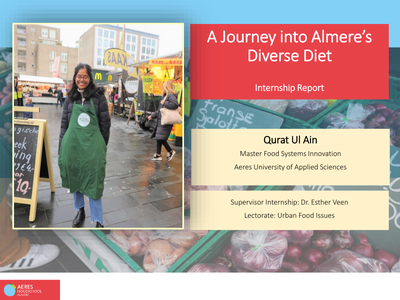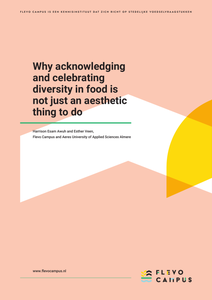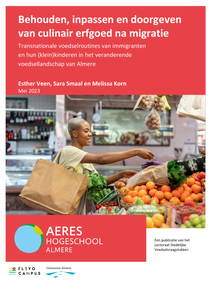LINK
The research sets out to explore what adult children of migrants consider to be their eating culture and food identity. We do so by looking at how they shop, cook, and eat on a daily basis and what foods they feel connected to. A secondary goal of this research is to understand how important sustainable food is for this group. For this report, we invited adult children of migrants, who grew up in Almere to share their stories. Being born in the Netherlands with parents who were born abroad – in our case Latin-America and the Caribbean – children of migrants grow up in two different food environments simultaneously. Outside the home, they are surrounded by a Dutch food environment, while the eating patterns in and around their household or wider family setting may reflect the backgrounds of their parents.
DOCUMENT

Food from home can increase feelings of belonging and act as a source of comfortfor people who move to another country and their children. Nevertheless, people whomove elsewhere often start taking over dietary elements of the host culture, a dynamicprocess referred to as food acculturation. This paper argues that this process is not only related to identity negotiations and emotional connections, but that food choices are also shaped by everyday practical realities. Using a social practice theory-inspired approach, focusing on the elements of material, competence, and meaning, this study investigates the food provisioning practices of eighteen people with a migration background through semistructured interviews.Keywords: migration; acculturation; food environment; procuring; cooking; eating; social practice theory
DOCUMENT

From the article: "This article evaluates the application of blockchain technology to improve organic or fair-trade food traceability from “Farm to Fork” in light of European regulations. This study aims to shed light on the challenges in the organic food chain to overcome, the drivers for blockchain technology, and the challenges in current projects."
DOCUMENT

There is a strong relation between food and identity. Especially when people move to another country, traditional food (or simply food from their country of origin), symbolizes a link with culture, communityand ethnic identity. As people move around the globe they introduce new foods in the places they land. Almere is becoming one of the largest majority minority cities of the Netherlands. Walking around thecity, the diversity of food ingredients and eating cultures as shown in shops and restaurants is immediately clear. The aim of this project was to get an insight into the diets of the residents of Almere so as to learn about eating patterns in a multicultural city and how multiculturality affects the diets of both newcomers and people who have been living here for generations.
DOCUMENT

It is believed that recognising and celebrating diversity in our foodscapes is the right thing to do. But why, really? What benefits make it paramount for this diversity to be lauded? This question needs answering to add more legitimacy to promoting urban food diversity. In this essay we try to do so by investigating the link between ‘recognition justice’ – the celebration of diversity –and inclusion, and understanding inclusion as vital for (social) sustainability. We use two research projects to demonstrate empirically-based lessons which can be drawn to support the need to recognise and celebrate diversity in our urban foodscape.
DOCUMENT

Op dinsdag 26 november 2019 hield Elies Lemkes-Straver - lector Duurzaam produceren in de agrifoodsector - onder grote belangstelling haar inaugurele rede bij HAS Hogeschool. "Je moet kunnen vaststellen waar je begint met duurzaamheid. En hoe je de ontwikkeling naar je duurzaamheidsdoelen inzichtelijk maakt. Hoe je jezelf en elkaar in de keten de maat neemt."
DOCUMENT

Abstract: Background For patients, seclusion during psychiatric treatment is often a traumatic experience. To prevent such experiences, adjustments in the design of seclusion rooms have been recommended. Methods As there have been no empirical studies on the matter, we used a quasi-experimental design to compare the experiences in seclusion of two groups of patients: 26 who had been secluded in a room designed according to the principles of healing environment, a so called ‘Enriched Environment Seclusion room’ (EES), and 27 who had been secluded in a regular seclusion (RS) room. The enrichment included audio-visual facilities, a fixed toilet, a couch and a self-service system to adjust light, colour, blinds and temperature according to the patient’s preferences. Insight into their experiences was obtained using the Patient View-of-Seclusion Questionnaire, which comprises nine statements on seclusion, supplemented with open-ended questions. Results The responses regarding seclusion experiences between the two groups did not differ significantly (U = 280.00, p = .21, r = -.17). Although those who had been secluded in the specially designed room had greatly appreciated the opportunities for distraction, and those who had been secluded in a regular seclusion room expressed the need for more distracting activities during seclusion, both groups described seclusion as a dreadful experience. If seclusion cannot be avoided, patients recommend facilities for distraction (such as those provided in an enriched environment seclusion room) to be available. Conclusion Whatever the physical environment and facilities of a seclusion room, we may thus conclude that seclusion is a burdensome experience.
DOCUMENT

Bitterness has been suggested to be the main reason for the limited palatability of several vegetables. Vegetable acceptance has been associated with preparation method. However, the taste intensity of a variety of vegetables prepared by differentmethods has not been studied yet. The objective of this study is to assess the intensity of the five basic tastes and fattiness of ten vegetables commonly consumed in the Netherlands prepared by different methods using the modified Spectrum method. Intensities of sweetness, sourness, bitterness, umami, saltiness and fattiness were assessed for ten vegetables (cauliflower, broccoli, leek, carrot, onion, red bell pepper, French beans, tomato, cucumber and iceberg lettuce) by a panel (n = 9) trained in a modified Spectrum method. Each vegetable was assessed prepared by different methods (raw, cooked, mashed and as a cold pressed juice). Spectrum based reference solutions were available with fixed reference points at 13.3 mm (R1), 33.3mm(R2) and 66.7mm(R3) for each tastemodality on a 100mmline scale. For saltiness, R1 and R3 differed (16.7 mm and 56.7 mm). Mean intensities of all taste modalities and fattiness for all vegetables were mostly below R1 (13.3 mm). Significant differences (p b 0.05) within vegetables between preparation methods were found. Sweetness was the most intensive taste, followed by sourness, bitterness, fattiness, umami and saltiness.In conclusion, all ten vegetables prepared by different methods showed low mean intensities of all taste modalities and fattiness. Preparation method affected taste and fattiness intensity and the effect differed by vegetable type.
DOCUMENT

In dit onderzoek onderzochten we hoe Almeerse inwoners met een niet-Nederlandse achtergrond (1e, 2de en 3de generatie) de voedselomgeving van Almere ervaren, en in hoeverre zij eten en koken uit de keuken(s) van hun voorouders. We hebben mensen met een migratieachtergrond geïnterviewd over hoe en waar zij boodschappen doen, wat zij koken en welke betekenis zij hechten aan eten en culturele gebruiken daaromtrent. Het is een vervolg op een eerder rapport van het lectoraat, ‘Wat schaft de pot in Almere?’ (Smaal en Veen 2023), waarin met een grootschalige enquête is verkend in hoeverre de bredere bevolking van Almere gebruik maakt van de multiculturele voedselomgeving.
DOCUMENT
